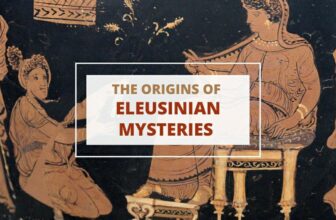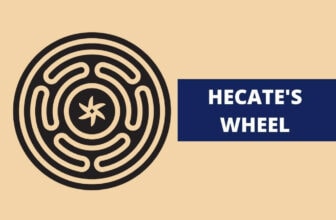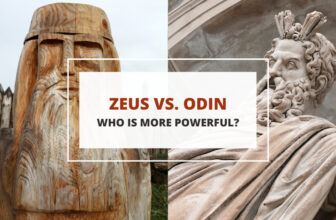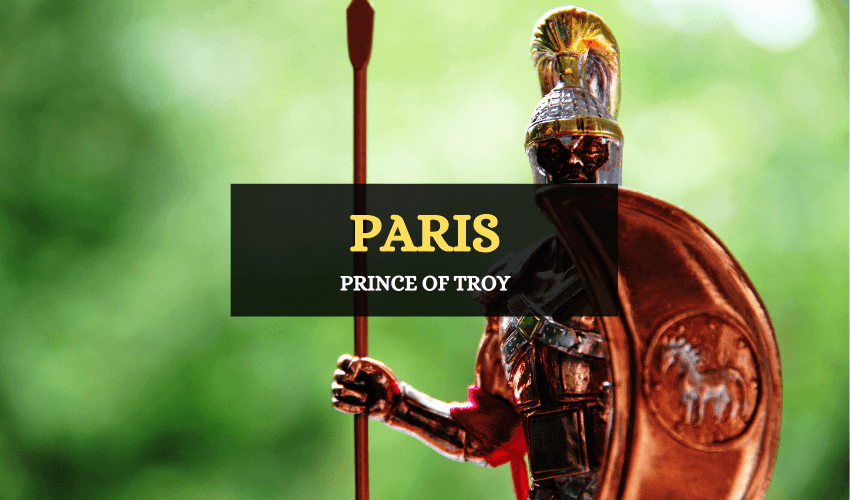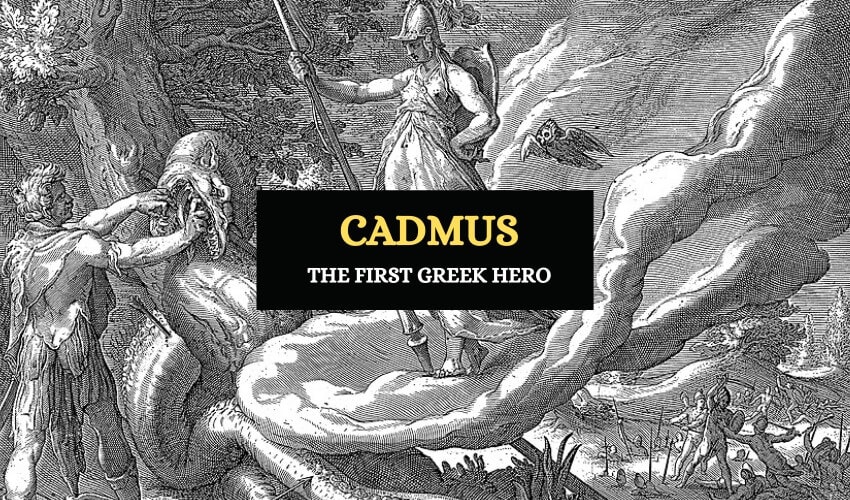
Table of Contents
Greek mythology is full of memorable Greek heroes, but Cadmus was the first of them. Just like Perseus and Bellerophon, Cadmus was one of the greatest heroes and slayer of monsters, long before the time of Heracles. But he is best known for founding the city of Thebes and becoming it’s first king. Let’s take a look at the great hero Cadmus and how he became a slayer of beasts.
Who Is Cadmus?
Cadmus was a Phoenician prince. His parents were King Agenor and Queen Telephassa of Tyre. His story begins when he was sent by his father to find his sister Europa, who had been abducted by Zeus. He was told not to return without her. As things turned out, Cadmus would never return home.
Searching for Europa
There are several versions, of Cadmus’s myth, from Homer (a brief mention), Herodotus (discusses his origins), Apollodorus (detailed account of his adventures), Ovid (transformation into snakes), and Euripides (later years), to name a few.
As the myth goes, after the abduction, Cadmus embarked on his quest to find his sister. As he traveled, he came to Samothrace, an island sacred to the Cabeiri. This was a group of deities associated with the earth and underworld, and known for their mysteries (initiation rites) . With him was his mother, Telephassa, and his brother Thasus.
After being initiated into the mysteries, which were the various religious rites and traditions, of Samothrace, Cadmus saw Harmonia, the goddess of harmony and concord, and daughter of Aphrodite. In some accounts, he carries her off with him with the help of the goddess Athena. This is quite an ironic turn of events in Cadmus’ story, mimicking the abduction of his own sister, Europa. However, in other versions, he meets and marries her later on.
The Oracle at Delphi
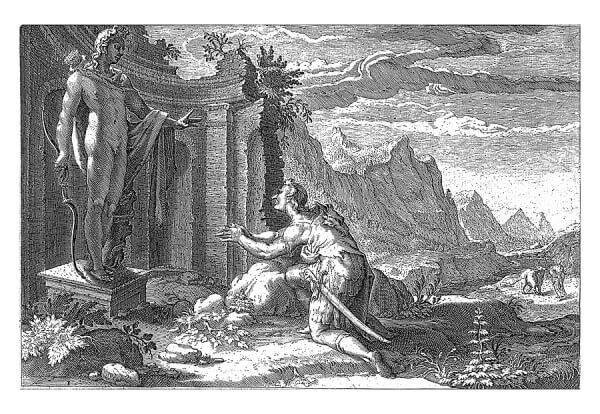
During his search for his sister, Cadmus came to Delphi where he consulted the oracle. After consulting with the gods, the oracle told him to give up trying to find his sister. He was then instructed to instead follow a special cow.
Cadmus was supposed to follow the cow until she lay down, exhausted, and to then build a town on that spot. The half-moon marked cow was given to Cadmus by the King of Phocis, Pelagon. Cadmus obeyed the oracle and followed the cow, who took him to Boeotia, the land on which he would found the city of Thebes.
Cadmus wanted to sacrifice the cow to Athena, so he sent some of his travelling companions to a nearby spring for water. His companions were subsequently killed by the water dragon guarding the spring.
Cadmus and the Dragon
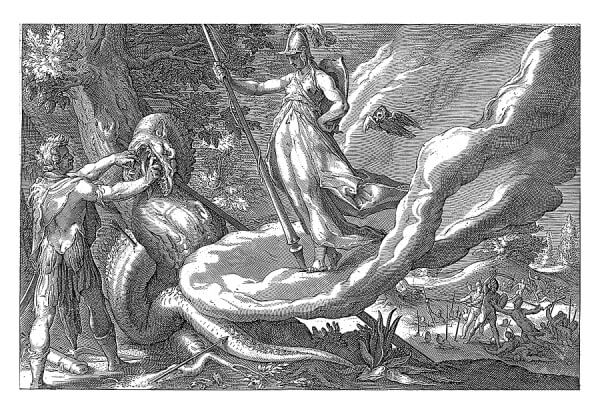
Cadmus had to avenge his companions, so the then made a detour and killed the dragon. Athena then appeared to him and told him to bury the dragon’s teeth in the ground. Cadmus did as she bid and from the teeth grew a race of warriors called the Spartoi.
Cadmus threw a stone at them and the warriors fought each other until only the strongest five remained. Those five were then tasked with helping Cadmus build the citadel of Thebes and later became the founders of the noblest families of Thebes.
Cadmus Works for Eight Years
Unfortunately for Cadmus, the dragon he killed was sacred to Ares, god of war. As recompense, Ares made Cadmus do penance for eight years by serving him. In some versions, it was only after this period, that Cadmus was given Harmonia as a wife. For the rest of his life, Cadmus was plagued by misfortune as a result of having killed the sacred dragon.
Children and Consort of Cadmus
The wedding of Cadmus and Harmonia was the first ever celebrated on Earth. At the wedding, all of the gods were present, and Harmonia received many bridal gifts. Of the gifts, she notably received a peplos (a body-length garment that was considered typical Greek women’s attire) created by Athena, and a necklace forged by Hephaestus, god of fire and the forge.
The necklace is known simply as the Necklace of Harmonia. It granted the person wearing it the ability to remain eternally young and beautiful, but at the cost of bringing terrible misfortune to all who possessed it. It supposedly brought misfortune to both Cadmus and Harmonia and played a role in the story of Oedipus and Jacosta as well as many others.
Cadmus and Harmonia began a dynasty with their sons Polydorus and Illyrius and their four daughters, Agave, Autonoë, Ino, and Semele.
The union of Cadmus and Harmonia symbolizes the merging of Eastern learning, represented by Cadmus of Phoenicia, with the Western love of beauty, symbolized by Harmonia of Greece. Additionally, Cadmus is also thought to have brought the Phoenician alphabet to the Greeks, who then used it as the foundation for their own Greek alphabet.
Cadmus Becomes a Serpent
Frustrated with his life, Cadmus commented that if the gods were so unhappy by the serpent/dragon he had killed, he wished he could be one himself. Instantly, he began to change, and scales emerged from his skin. Harmonia, upon seeing her husband’s transformation, begged the gods to also change her into a serpent to match his form. The gods granted her wish and they were both transformed into serpents.
Symbols of Cadmus
- Dragon/serpent: Cadmus is famously associated with the dragon he slew near Thebes. Cadmus and Harmonia also turned into serpents in some versions of their myth. Because of this, the dragon (sometimes represented as a serpent) is a symbol of Cadmus.
- Dragon’s teeth: After slaying the dragon, Cadmus, on Athena’s advice, sowed the dragon’s teeth into the ground, from which sprang the Spartoi, fully armored warriors. Therefore, the teeth represent Cadmus’ journey into establishing Thebes and becoming a king.
- The cow: At the beginning of his journey to found Thebes, Cadmus was advised to follow a special cow and to establish a city where the cow would lie down, which would become Thebes.
- Phoenician alphabet: Cadmus is credited with introducing the Phoenician alphabet to the Greeks. This alphabet became the basis for the Greek alphabet, which in turn influenced many of the world’s writing systems.
- Harmonia’s necklace: Cadmus gave Harmonia a necklace as a wedding gift, which in some stories is described as cursed. This necklace, often said to bring misfortune to its wearer, was passed down through generations and played a role in various Greek myths.
Cadmus in Modern Times
Cadmus’ name is often used in fiction as a shorthand for nobility or divine descent or creation. In the DC Comic Universe, Project Cadmus is a fictional genetic engineering project that creates the powerful superheroes: Golden Guardian, Auron, Superboy, and Dubbilex.
Similarly, in the game Warhammer 40K, the House Cadmus is an Imperial Knight House known for their fighting ability and for their long-standing conflict with the terrifying beasts of the land.
Cadmus Facts
Cadmus is the founder of Thebes and the first Greek hero.
Cadmus was a mortal, the son of the king of Phoenicia. He was later turned into a serpent.
Cadmus’ siblings include Europa, Cilix and Phoenix.
Cadmus is advised by the gods to give up the quest for Europa and instead marries Harmonia and founds Thebes.
Cadmus marries Harmonia, daughter of Aphrodite.
Cadmus has five children – Semele, Polydorus, Autonoe, Ino and Agave.
Cadmus is frustrated with the many misfortunes of his life and wished that he could become a serpent to live more freely.
Wrapping Up
Cadmus was the father to several generations of Thebes’ kings and queens. Ultimately, he almost single-handedly founded one of the great Greek cities while also spawning a dynasty of rulers. While Cadmus’ story is lesser known than some of his contemporaries, echoes of it can still be found in modern day fiction.




